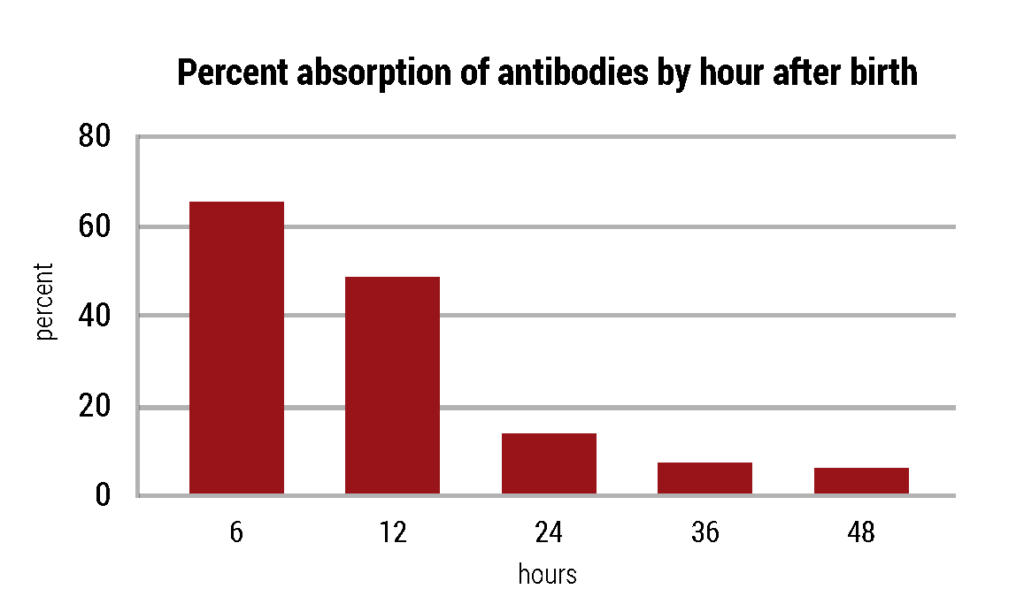Emily Middleton-Gyomory, Regional Consulting Manager

Efficiency of absorption declines from birth, particularly after 12 hours. Feeding may induce earlier closure, but there is little colostral absorption after 24 hours of age even if the calf is starved. This principle for timing of colostrum feeding holds true whether the colostrum is directly from the first milk of the dam or supplied by hand feeding the baby calf previously obtained colostrum.2
School is in session and kids are already bringing home the first round of fall colds. Similarly, fall is a challenging time for calf health for both dairy and beef producers. Adding pressure to this challenge is the high value of replacements whether they are dairy, beef, or beef x dairy. It is critical to get these valuable replacements off to a good start.
Calves need a strong immune system to fight off illness. Feeding enough high-quality colostrum is critical to building that immunity. Colostrum quantity, however, can be a challenge during fall and winter months. The industry doesn’t fully understand why, but some research has pointed to the shorter daylight in fall and winter. Dry-cow-management-and-nutrition solutions are inconclusive, so the general recommendation is to bank high quality colostrum or use colostrum replacer. In a 2021 study by Rossi et al., in Michigan, calves that received a second colostrum feeding had better growth rates pre-weaning, were less likely to be treated for an illness, and tended to produce more milk in their first lactation. Michigan State University Extension recommends a second meal of colostrum six to 12 hours after the first feeding, at a volume of two to three quarts. Given the benefits of a second colostrum feeding and the challenges of getting enough colostrum in the fall and winter, colostrum replacer may be a viable option to get calves off to a good start. Falling temperatures and damp weather increases the risk of respiratory illnesses in the fall and winter. Dairy calves born in the fall are more likely to be treated for pneumonia compared to calves born in the other seasons1. Often, beef calves are weaned and transported in the fall, putting them at a higher risk for pneumonia, too. Providing dry, clean bedding with a high plane of nutrition and a solid vaccination protocol is imperative. The old adage, “an ounce of prevention is worth a pound of cure” has real meaning when it comes to calf health.
A meta-analysis published in the Journal of Dairy Science found dairy heifers diagnosed with pneumonia as a calf were twice as likely to leave the herd before their first calving, had reduced daily gains and produced 267 less pounds of milk in their first lactation. Similarly, beef calves also have reduced daily gains and feed-conversion efficiency. These long-term-production losses are in addition to the cost of treatment. With these factors in mind, fall is an ideal time to incorporate immune-support products into your calf-management strategy to mitigate these risks and protect future performance. Despite all our best efforts, some calves will still get sick. Antibiotics are needed to treat these sick calves, but supportive care is essential too. In addition to a clean, dry environment with fresh water, dehydrated calves may need electrolytes. Probiotics are also beneficial in restoring gut health, especially after antibiotic treatment.
While there are seasonal challenges it’s important to prevent and treat calf illness year-round. According to the USDA National Animal Health Monitoring System (NAHMS), the greatest risk for disease or death in dairy cattle is the period from birth to weaning. The genetics of a dairy heifer, beef calf, or beef x dairy calf determine their potential, but how they’re raised and managed will determine how they perform. Let’s make every replacement count.
References: 1Closs & Dechow, 2017. 2 bovinevetonline.com/news/veterinary-education/most-passive-immunity-occurs-first-six-hours
